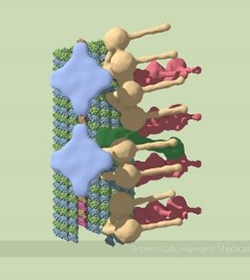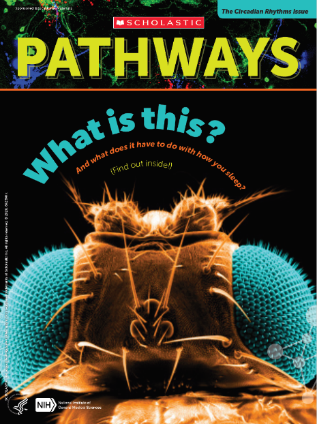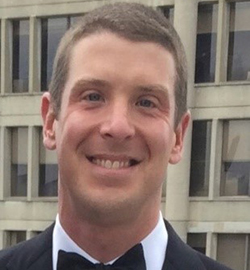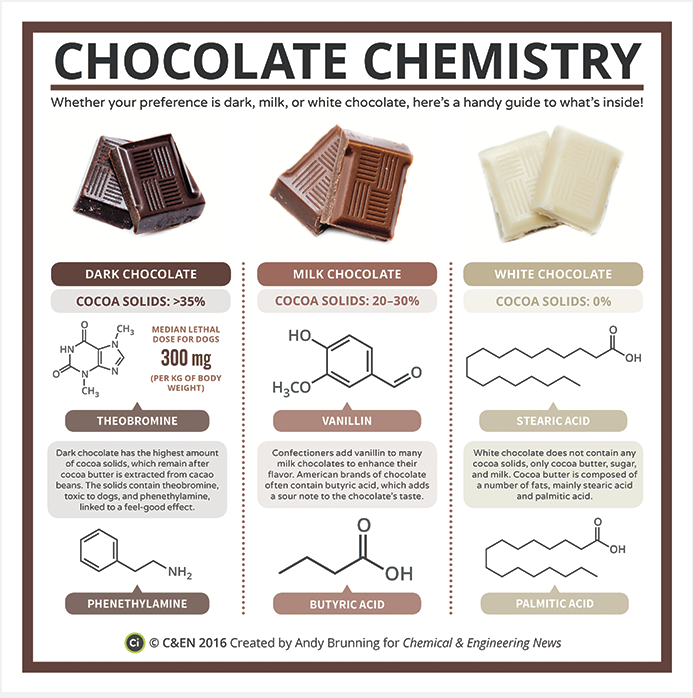Author: Abbey Bigler-Coyne
Abbey is a science writer who enjoys making important biological science and public health information accessible to everyone.
Posts by Abbey Bigler-Coyne
Note to our Biomedical Beat readers: Echoing the sentiments NIH Director Francis Collins made on his blog, NIGMS is making every effort during the COVID-19 pandemic to keep supporting the best and most powerful science. In that spirit, we’ll continue to bring you stories across a wide range of NIGMS topics. We hope these posts offer a respite from the coronavirus news when needed.

A cell nucleus (blue) surrounded by lipid droplets (yellow). Credit: James Olzmann.
Within our cells, lipids are often stored in droplets, membrane-bound packages of lipids produced by the endoplasmic reticulum. For many years, scientists thought lipid droplets were simple globs of fat and rarely studied them. But over the past few decades, research has revealed that they’re full-fledged organelles, or specialized structures that perform important cellular functions. The field of lipid droplet research has been growing ever since.
Continue reading “PECASE Honoree James Olzmann Investigates the Secrets of Lipid Droplets”

A partial model of a doublet microtubule. Credit: Veronica Falconieri.
Cilia (cilium in singular) are complex organelles found on all of our cells except red blood cells. Their rhythmic beating moves fluid or materials over the cell to help transport food and oxygen or remove debris. For example, cilia in our windpipe prevent bacteria and mucous from traveling to the lungs. Some pick up signals like antennae, such as cilia in our ears that help detect sounds. One component of cilia is the doublet microtubule, a major part of cilia’s skeleton that gives it strength and rigidity.
Continue reading “Revealing a Piece of Cilia’s Puzzle”

Cover of
Pathways student magazine.
NIGMS and Scholastic, Inc., bring you the third edition of Pathways, a collection of free resources that teaches students about basic science and its importance to health, and exciting research careers.
Pathways is designed for grades 6 through 12. The topic of this unit is circadian rhythms, the “schedules” our bodies follow over the course of a day. These rhythms influence processes like hunger and the sleep-wake cycle.
Continue reading “Pathways: The Circadian Rhythms Issue”

Sohini Ramachandran, Brown University.
Credit: Danish Saroee/Swedish Collegium for Advanced Study.
Recent advances in computing enable researchers to explore the life sciences in ways that would have been impossible a few decades ago. One new tool is the ability to sequence genomes, revealing people’s full DNA blueprints. The collection of more and more genetic data allows researchers to compare the DNA of many people and observe variations, including those shared by people with a common ancestry.
Sohini Ramachandran  , Ph.D., is director of the Center for Computational Molecular Biology and associate professor of biology and computer science at Brown University in Providence, Rhode Island. She is also a recent recipient of the Presidential Early Career Award for Scientists and Engineers (PECASE). Dr. Ramachandran researches the causes and consequences of human genetic variations using computer models. Starting with genomic data from living people, her lab applies statistical methods, mathematical modeling, and computer simulations to discover how human populations moved and changed genetically over time.
, Ph.D., is director of the Center for Computational Molecular Biology and associate professor of biology and computer science at Brown University in Providence, Rhode Island. She is also a recent recipient of the Presidential Early Career Award for Scientists and Engineers (PECASE). Dr. Ramachandran researches the causes and consequences of human genetic variations using computer models. Starting with genomic data from living people, her lab applies statistical methods, mathematical modeling, and computer simulations to discover how human populations moved and changed genetically over time.
Continue reading “PECASE Honoree Sohini Ramachandran Studies the Genetic Foundations of Traits in Diverse Populations”
Chocolate is a Valentine’s Day must-have and popular among people with a sweet tooth. Many also claim it lifts mood or even acts as an aphrodisiac, and we’ve all heard someone say it’s habit forming.
The compounds in chocolate that allegedly have positive effects come from the cacao bean, so the darker the chocolate, the more of these compounds it contains. Milk chocolate has less than dark chocolate, and white chocolate has nearly none because it includes no cocoa solids, only cocoa butter.
Does science back up the common claims about chocolate? To find the answers, we’re taking a look at the chemistry behind this treat.
Continue reading “The Chemistry of Chocolate”

Michael Boyce, associate professor of biochemistry at Duke University in Durham, North Carolina. Credit: Michael Boyce.
Sugars aren’t merely energy sources for our cells. They also play important signaling roles through a process called glycosylation, where they attach to proteins and lipids as tags. Although these sugar tags, called glycans, impact many cellular processes, they have long been understudied due to technical challenges. Now, advances in analytical tools like mass spectrometry are enabling scientists to examine the enormous complexity of glycans. Other advances also allow researchers to synthesize complex sugars, providing them with standards for analytical experiments.
Continue reading “PECASE Honoree Michael Boyce on Sugar’s Role in Cell Signaling and on Diversity, Equity, and Inclusion in the Scientific Workforce”
Over the past 12 months, we’ve explored a variety of topics in genetics, cell biology, chemistry, and careers in the biomedical sciences. As we ring in the new year, we bring you our top three posts of 2019. If your favorite is missing, let us know what it is in the comments section below!

Hawaiian bobtail squid. Credit: Dr. Satoshi Shibata.
Studying research organisms, such as those featured in this post, teaches us about ourselves. These amazing creatures, which have some traits similar to our own, may hold the key to preventing and treating an array of complex diseases.
Continue reading “Looking Back at the Top Three Posts of 2019”
 A cell nucleus (blue) surrounded by lipid droplets (yellow). Credit: James Olzmann.
A cell nucleus (blue) surrounded by lipid droplets (yellow). Credit: James Olzmann.


 A partial model of a doublet microtubule. Credit: Veronica Falconieri.
A partial model of a doublet microtubule. Credit: Veronica Falconieri.
 Cover of Pathways student magazine.
Cover of Pathways student magazine.
 Sohini Ramachandran, Brown University.
Sohini Ramachandran, Brown University.

 Michael Boyce, associate professor of biochemistry at Duke University in Durham, North Carolina. Credit: Michael Boyce.
Michael Boyce, associate professor of biochemistry at Duke University in Durham, North Carolina. Credit: Michael Boyce.
 Hawaiian bobtail squid. Credit: Dr. Satoshi Shibata.
Hawaiian bobtail squid. Credit: Dr. Satoshi Shibata.